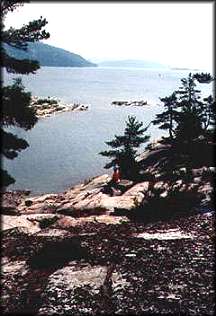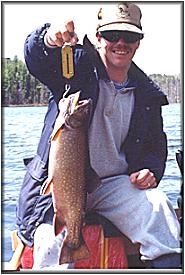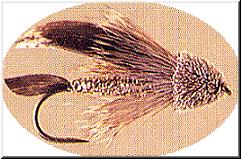WHERE EAST BEATS WEST!
By Kevin Fancy
In eastern Ontario there are very few trout waters where one can ply the
craft of fly fishing the old fashioned way. That is to say, chest deep in water so
cold your nether parts develop a noticeable type of hypothermia that
slowly, after a few hours, creeps up to the brain. Come to think of it,
maybe it's a blessing that we are so short of cold rushing trout rivers
and our families are considerably bigger.
If you do like to wade, eastern Ontario can offer many opportunities in
the department of more heavily scaled fish varieties. Warmer rivers,
mostly fed by surface water supplied lakes, abound with crappie, bass
(of both kinds), pike and muskie as well as all the other species of pan
and course fish. They don't look or taste like trout but when it comes
to fight, I'll put a bass or a big pike against a trout for fun any day.

That is not to say that we don't have trout waters in eastern Ontario.
The majority of trout found here however are the lake dwelling
varieties. I have been chasing Ontario's "lake living" trout for more
than fifteen years. I have come to know the best ways to catch them. In
doing so have been shunned by a large portion of the fly fishing
community. When fishing a body of water miles across, miles long and
sometimes hundreds of feet deep, convention goes out the window for
practicality. I have therefore, for many successful years, resorted to
the art of fly trolling.

I know, pitch a length of hemp over the yardarm. That's not real
fly-fishing you say. I've heard it all and it's as legitimate a method
of fly fishing as dabbling your top dropper or nibbling your dog nobbler,
whatever. Fly trolling is merely an alternate method to traditional
water whipping. In Scotland trolling it is called Loc style fishing and
is quite common. There however, they take advantage of the ever present
winds and a drogue or drift sock, as we know it. It's a very
uncontrolled drift, but a method of trolling nonetheless. I simply take
it one step further and add an electric motor or a pair of oars. My
trolling patterns tend to follow shorelines or structure but little else
is different from the Scottish method.
 When trolling, your fly is always on the move with bursts of power as
you tease the rod forward. This action makes Wooly Buggers flare and
Marabou Muddlers appear to pause. It is at these points of pause where
most strikes occur. That, and when you are on the side of the boat
enjoying an outside turn and your fly rises and speeds up at the same
time.
When trolling, your fly is always on the move with bursts of power as
you tease the rod forward. This action makes Wooly Buggers flare and
Marabou Muddlers appear to pause. It is at these points of pause where
most strikes occur. That, and when you are on the side of the boat
enjoying an outside turn and your fly rises and speeds up at the same
time.

Hits that occur while trolling are swift and violent. A small Brown of
three pounds will wake you up and almost snap your wrist. A rainbow of
five pounds can stop a boat dead in the water or send it for a sharp
turn. Fun stuff at five a.m.while you are pouring the first hot coffee
of the day. The best baits I have found for trolling are attractors. I
surmise this is due to the speed. Fish don't have a chance to study the
bait and hit something visable out of instinct. No matter where you
fish colours like orange, yellow and purple seem to be the best
producers. The only exception to the rule is the Muddler Minnow. It
seems to produce any time anywhere. A good speed to troll at is about
three miles an hour (or about a slow walking speed). On active days
SLOW down your troll and on slow days SPEED up. Use a good sinking line
or sinking tip and pay out all your line to the backing, to tempt the
wary fish that avoid your boat noise.
Well that's it. Trolling in the basic form. I may come back and talk
about this later and maybe even pass along some of my favourite patterns
at a later date. That is unless I am bumped off the site or hung for
the sport of crows for mentioning such a thing as trolling with flies.
Till next time, Happy Hooking!
~ Kevin Fancy
If you would like to comment on this or any other article please feel free to
post your views on the FAOL Bulletin Board!
Our Man In Canada Archives
|





